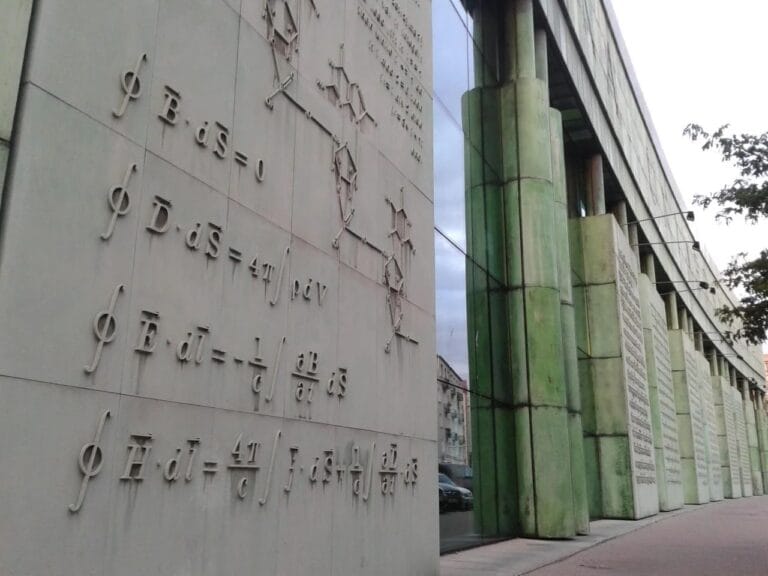Now, let’s speak honestly. There are discoveries in the history of science that are not just “data collection” or “formula invention”. These are, as you know, the pinnacle of creative imagination. Einstein’s General Theory of Relativity (GTR) is exactly this.
The matter is simple: Newton says that gravity is a force. Einstein said, nonsense. Objects are not pulling each other; they are only reacting to a curvature in the geometric fabric of space and time. That is, if the ball does not fall when we throw it in the air, the reason is not that a force is pulling it; it is rolling towards us while trying to go straight because the ground beneath it (spacetime) is warped. This theory is accepted as beautiful as a work of art. In fact, strangely enough, the evidence supporting it was not even as strong or comprehensive as the evidence supporting Quantum Theory. But the comprehension was so aesthetic that no one wanted to believe such a beautiful thing could be wrong. Since 1915, it continues to win every test.
The Genius’s Lockdown Moment: Autumn 1912
Einstein struggled for exactly eight years (1907-1915) to find GTR. But the most agonizing and intense moments coincide with the period between the late summer of 1912, when he moved from Prague to Zurich, and the beginning of 1913. These are exactly the moments we would want to look over his shoulder. Luckily, we can look. Because there is a small, brown notebook where he kept his special calculations during this period: the Zurich Notebook.
This notebook came out from among his papers when he died in 1955. Even before August 1912, Einstein was trying to combine gravity with special relativity, but these efforts remained quite basic compared to the genius that followed. Then, he saw that key connection between gravity and non-Euclidean geometry. That is, he realized that by curving spacetime, we could include the most general gravitational fields. This notebook tells the story of the effort to reach the main equations of this idea.
The Two-Covered Notebook and Confusing Puzzles
The notebook’s character is interesting; it has two front covers because Einstein took notes from both directions. On one cover, his secretary Helen Dukas labeled it “Lecture Notes on Relativity”. When the notebook is turned over, the word “Relativity” in Einstein’s own handwriting appears before us. But the inside is a complete shock. Right inside that cover labeled “Relativity,” instead of the universe’s most complex equations, there are incredibly human doodles, that is, mathematical recreational puzzles. In one, there are the maneuvers of train wagons, and in the other, that famous 64=65 illusion.

You know that trick where you cut an 8×8 square and reassemble the pieces to make a 13×5 rectangle, resulting in an extra unit of area. Einstein knew this was a trick, but he was struggling to figure out where the deception lay. This detail inevitably makes one wonder: Was the man who was rewriting the universe also relaxing his mind with this area illusion? Maybe he wanted to entertain his children, who knows.
Key Point: Line Element
Seriousness begins where the fun ends. The first page on the other side of the notebook begins by recounting Minkowski’s four-dimensional spacetime approach (x1, x2, x3, x4), that is, the fundamentals of relativity. This is a kind of warm-up.

After 13 pages of notes on electrodynamics and thermal physics, the transition is made without warning. At the top of the page, the basic concept of GTR, the “line element” equation, appears. This expression allows us to calculate the spacetime interval (ds) between events. If the coefficients calculating this interval (Gμν, now the metric tensor) are not suitable for a flat geometry, then we have captured exactly the gravitational effects in Einstein’s general theory.
Einstein was most likely writing this expression for the first time in this notebook. Initially, he wrote the coefficients with capital G (Gμν), but after a few pages, he switched to the lower case g, which would become standard. The main goal of the project was simple but difficult: to find out how this metric tensor (gμν) is generated by source masses. This would be the General Theory of Relativity’s counterpart to Newton’s inverse square law.
The first attempts were very amateur. He chose a “special case” (Spezialfall). He examined a situation where almost all coefficients of the metric tensor returned to the values of special relativity, with only the G44 = c2 component changing. Right on the opposite page, he asks a beginner-level question: “Ist dies invariant?” (“Is this invariant?”). That is, does the formula remain the same even if we change the coordinate system? Calculations showed that it did not change. Moreover, during this period, he was not yet using modern tensor calculus (Ricci and Levi-Civita techniques); he was struggling with Beltrami’s old methods.
The Secret of the Shortest Path on a Curved Surface
After the analysis continued for three more pages, a truly fascinating page appeared in the notebook. Einstein delved into classical physics to understand the basic logic of his new theory. The question was: If a mass moves freely but is forced to remain trapped on a curved surface, what is the path it follows on the surface? Answer: The surface’s geodesic (the shortest distance curve). This result was frighteningly close to the central idea of GTR. A mass in free fall moves through the curvature of spacetime, and the path it follows is the geodesic of spacetime (the most extreme spacetime interval). On this page, Einstein was struggling with calculus to find this geodesic.
“Stimmt!” and Missing Pieces
When the calculations met in the middle of the notebook, we turn the notebook over and start again from the back cover. On this side, there are first thermal physics calculations (Planck formula, taking the derivative with respect to temperature to derive the 1909 fluctuation formula). Nine pages later, we fall right into the middle of GTR again under the heading “Gravitation” .
This time he is working on the conservation of energy and momentum equations . Starting from the equation of motion for a point mass (geodesic equation), he applies it to a cloud of non-interacting dust particles in free fall and arrives at the condition that the covariant divergence of the stress energy tensor (Tμν) must be zero However, Einstein was not sure whether this operator was generally covariant (independent of the coordinate system).
He calculated an expression to check, and saw that it was zero. Satisfied, he wrote his note at the bottom of the page: “Stimmt” — “Correct.” He had produced one of the basic operators of tensor calculus using his own physical argumentation. He had the right to feel slightly smug in these moments.
The subsequent pages were filled with complex efforts aimed at creating invariant quantities by examining the properties of the determinant G of the metric tensor. He even identified a “hypothesized gravitation tensor”. However, a major shortcoming stood out in these efforts: the sophisticated techniques of Ricci and Levi-Civita that generate invariants from the derivatives of the metric tensor, that is, modern tensor calculus, were absent. Most importantly, the fourth rank Riemann curvature tensor, which we easily use to form the field equations, was not present.
Grossmann Tensor Fourth Rank
Finally, the missing piece is completed. In the later pages of the notebook, Einstein writes the formula for the Riemann tensor at the top of the page. The rumor is that his school friend Grossmann taught him these techniques . Indeed, next to this formula in the notebook, there is such a notation: “Grossmann tensor fourth rank”. He got the formula from his buddy, and noted it without hesitation . He now had the right tool. By contracting the Riemann tensor, he obtained the simpler Ricci tensor . For the Ricci tensor to work as a gravitational tensor, it had to be reduced to the Newtonian form in the weak field limit . This means that three of the four second-derivative terms had to vanish . Einstein wrote his note next to these terms: “Sollte verschwinden” — “Should vanish”.

Eliminating these three unwanted terms became a huge obstacle for Einstein in the following pages . The calculations became so long that at one point he cut off an operation, saying “zu umstaendlich” — “too involved”. Even though he was a genius, he was drowning among piles of symbols.
Certain Result, Short-Lived Happiness
We modern relativists solve this problem by restricting the coordinate system. Einstein also shows that he eventually entered this path. His fatigue is evident even in the title: “Nochmalige Berechnung des Ebenentensors” — “The Computation of the Surface Tensor Once Again”.
In this calculation, he applies a restriction necessary to save the Newtonian limit, which we now know as the “harmonic coordinate condition”. By fulfilling this condition, he successfully rescues the Newtonian limit equations. He is sure of the result and writes at the bottom of the page: “The result is certain. Holds for coordinates that satisfy the Eqn Δφ=0” (The result is certain. Valid for coordinates that satisfy the harmonic condition) . But this certainty, my friend, lasted very briefly.
Immediately after, while examining a special case for static fields (“Statischer Spezialfall”) , he makes a big mistake. His assumption was: In the coordinates where the Newtonian limit emerges, only one of the ten components of the metric tensor (g44) should change with the coordinates. The others had to remain constant. This assumption was enough to collapse the entire modern solution.
The result appears on the page: “special case probably incorrect” — “the special case is probably wrong”. And the “harmonic condition” quietly disappeared from the notebook. Einstein did not give up; he tried new solutions , and identified new hypothetical tensors. He even found another way to derive the Newtonian limit from the Riemann tensor . But to no avail. Works based on the Riemann tensor did not last more than a few pages . In mid-1913, complete surrender occurred. Together with his school friend Grossmann, he published the complex “Entwurf” equations, whose general covariance was unknown (meaning they were not valid in every coordinate system). The summary of the derivation of these equations in the notebook is written more neatly than the chaos on the other pages, looking as if they were copied later.
By choosing these “Entwurf” equations, Einstein entered a “darkness” that lasted more than two years, restless and unsettling. He wandered knowing he was wrong throughout those two years, until he returned to successfully finding the generally covariant field equations in late 1915. Ultimately, the Zurich Notebook is a unique document showing the clutter on a genius’s desk, those small victories (Stimmt!), big disappointments (probably incorrect), and most importantly, how chaotic and human a process even the greatest theory went through..






